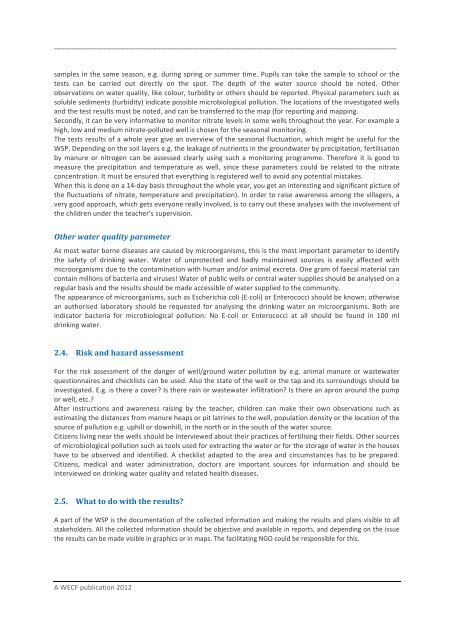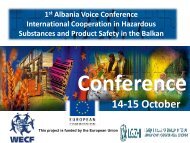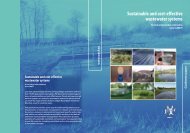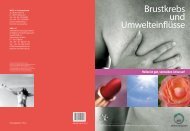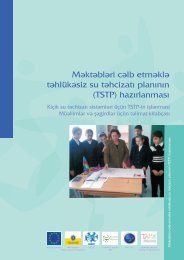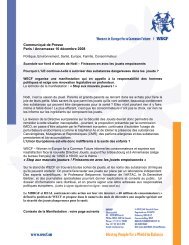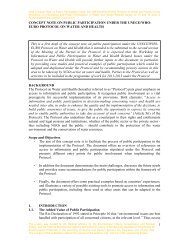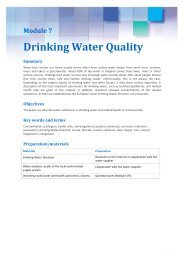Local Action for Safe Water - WECF
Local Action for Safe Water - WECF
Local Action for Safe Water - WECF
You also want an ePaper? Increase the reach of your titles
YUMPU automatically turns print PDFs into web optimized ePapers that Google loves.
___________________________________________________________________________<br />
samples in the same season, e.g. during spring or summer time. Pupils can take the sample to school or the<br />
tests can be carried out directly on the spot. The depth of the water source should be noted. Other<br />
observations on water quality, like colour, turbidity or others should be reported. Physical parameters such as<br />
soluble sediments (turbidity) indicate possible microbiological pollution. The locations of the investigated wells<br />
and the test results must be noted, and can be transferred to the map (<strong>for</strong> reporting and mapping.<br />
Secondly, it can be very in<strong>for</strong>mative to monitor nitrate levels in some wells throughout the year. For example a<br />
high, low and medium nitrate-‐polluted well is chosen <strong>for</strong> the seasonal monitoring.<br />
The tests results of a whole year give an overview of the seasonal fluctuation, which might be useful <strong>for</strong> the<br />
WSP. Depending on the soil layers e.g. the leakage of nutrients in the groundwater by precipitation, fertilisation<br />
by manure or nitrogen can be assessed clearly using such a monitoring programme. There<strong>for</strong>e it is good to<br />
measure the precipitation and temperature as well, since these parameters could be related to the nitrate<br />
concentration. It must be ensured that everything is registered well to avoid any potential mistakes.<br />
When this is done on a 14-‐day basis throughout the whole year, you get an interesting and significant picture of<br />
the fluctuations of nitrate, temperature and precipitation). In order to raise awareness among the villagers, a<br />
very good approach, which gets everyone really involved, is to carry out these analyses with the involvement of<br />
the children under the teacher’s supervision.<br />
Other water quality parameter<br />
As most water borne diseases are caused by microorganisms, this is the most important parameter to identify<br />
the safety of drinking water. <strong>Water</strong> of unprotected and badly maintained sources is easily affected with<br />
microorganisms due to the contamination with human and/or animal excreta. One gram of faecal material can<br />
contain millions of bacteria and viruses! <strong>Water</strong> of public wells or central water supplies should be analysed on a<br />
regular basis and the results should be made accessible of water supplied to the community.<br />
The appearance of microorganisms, such as Escherichia coli (E-‐coli) or Enterococci should be known; otherwise<br />
an authorised laboratory should be requested <strong>for</strong> analysing the drinking water on microorganisms. Both are<br />
indicator bacteria <strong>for</strong> microbiological pollution: No E-‐coli or Enterococci at all should be found in 100 ml<br />
drinking water.<br />
2.4. Risk and hazard assessment<br />
For the risk assessment of the danger of well/ground water pollution by e.g. animal manure or wastewater<br />
questionnaires and checklists can be used. Also the state of the well or the tap and its surroundings should be<br />
investigated. E.g. is there a cover? Is there rain or wastewater infiltration? Is there an apron around the pump<br />
or well, etc.?<br />
After instructions and awareness raising by the teacher, children can make their own observations such as<br />
estimating the distances from manure heaps or pit latrines to the well, population density or the location of the<br />
source of pollution e.g. uphill or downhill, in the north or in the south of the water source.<br />
Citizens living near the wells should be interviewed about their practices of fertilising their fields. Other sources<br />
of microbiological pollution such as tools used <strong>for</strong> extracting the water or <strong>for</strong> the storage of water in the houses<br />
have to be observed and identified. A checklist adapted to the area and circumstances has to be prepared.<br />
Citizens, medical and water administration, doctors are important sources <strong>for</strong> in<strong>for</strong>mation and should be<br />
interviewed on drinking water quality and related health diseases.<br />
2.5. What to do with the results?<br />
A part of the WSP is the documentation of the collected in<strong>for</strong>mation and making the results and plans visible to all<br />
stakeholders. All the collected in<strong>for</strong>mation should be objective and available in reports, and depending on the issue<br />
the results can be made visible in graphics or in maps. The facilitating NGO could be responsible <strong>for</strong> this.<br />
A <strong>WECF</strong> publication 2012


